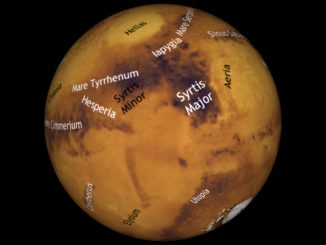
As NASA’s Perseverance Mars rover hurtles toward the red planet to search for signs of ancient microbial life in river delta and lakebed deposits, new research indicates many of the valley networks scarring the surface of Mars were caused by water melting under glacial ice, not by free-flowing rivers.
The research, led by postdoctoral scholar Anna Grau Galofre of Arizona State University, would appear to throw cold water, so to speak, on the idea that Mars once was a warmer, wetter world covered by rivers, lakes and even oceans.
“These results are the first evidence for extensive subglacial erosion driven by channelized meltwater drainage beneath an ancient ice sheet on Mars,” said Mark Jellinek, professor at the University of British Columbia and co-author of a paper in Nature Geoscience.
As it turns out, subglacial channels on Devon Island in the Canadian arctic are strikingly similar to valley networks seen on Mars. That prompted a comparative study that included 10,000 martian valleys. Grau Galofre, a former Ph.D. student at the University of British Columbia, developed an algorithm that helped researchers infer underlying erosion processes.
“For the last 40 years, since Mars’s valleys were first discovered, the assumption was that rivers once flowed on Mars, eroding and forming all of these valleys,” said Grau Galofre.
“But there are hundreds of valleys on Mars and they look very different from each other. If you look at Earth from a satellite you see a lot of valleys: some of them made by rivers, some made by glaciers, some made by other processes, and each type has a distinctive shape. Mars is similar, in that valleys look very different from each other, suggesting that many processes were at play to carve them.”
The research indicates many martian valleys likely formed some 3.8 billion years ago when the Sun was less intense than it is today. That, coupled with Mars’ greater distance from the Sun, would have resulted in a colder climate.
“Climate modelling predicts that Mars’ ancient climate was much cooler during the time of valley network formation,” said Grau Galofre. “We tried to put everything together and bring up a hypothesis that hadn’t really been considered: that channels and valleys networks can form under ice sheets, as part of the drainage system that forms naturally under an ice sheet when there’s water accumulated at the base.”
While at odds with the widely accepted view of ancient Mars as a warmer, wetter and more generally habitable world in the distant past, the research does not mean Perseverance and other missions looking for signs of past life on Mars are in vain.
Mars might still have offered habitable environments beneath the ice sheet, which would have shielded microbial life from harsh solar radiation in the absence of a magnetic field.



